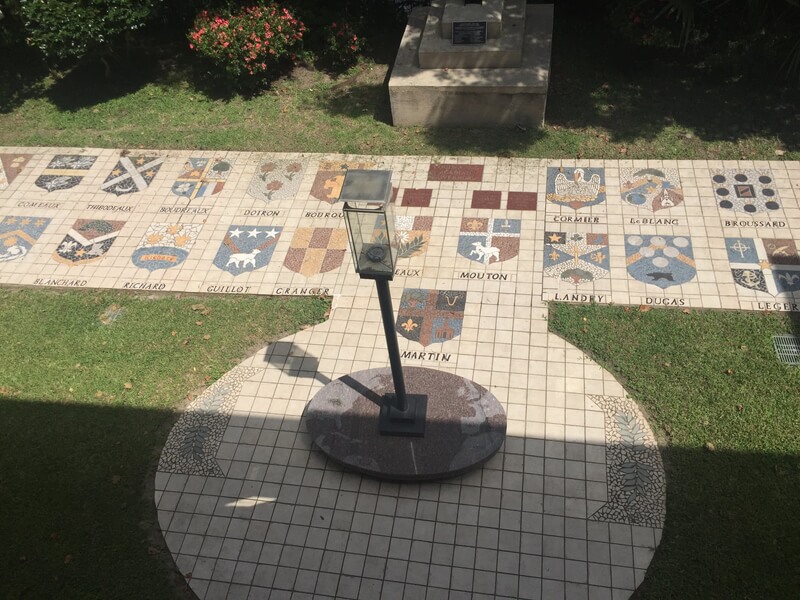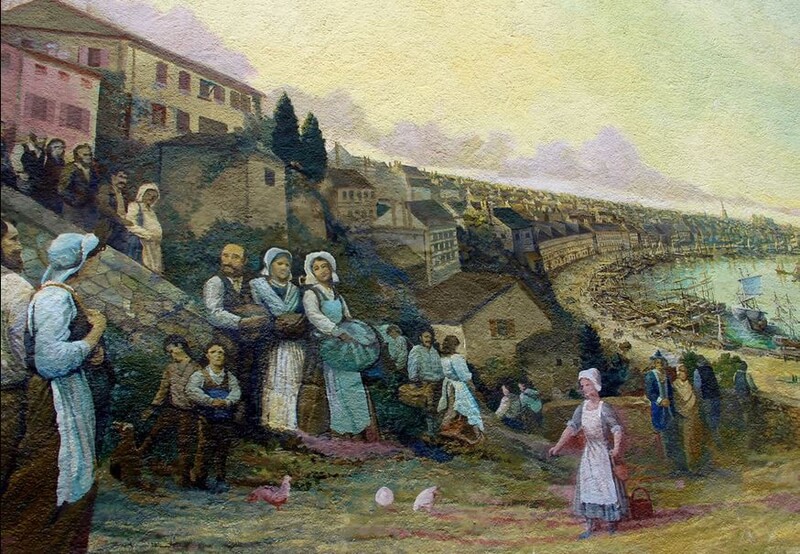Genealogy
Ensemble Encore: Instructions
Family Names:
Surname Guide
The heart of the upstairs research center consists of a database of biographical sketches of all the Acadian exiles known to have arrived in Louisiana. Those exiles who have been identified are included on the Wall of Names on the first floor of the Memorial. Location of the biographical sketches of these Acadian immigrants is based in large part upon a surname search. The names of individuals in the sketches are drawn from the Wall of Names.
As seasoned genealogists are painfully aware, there was no attempt to standardize the spelling of surnames until the nineteenth century. Surnames were rendered phonetically. This creates a particular problem for Acadian genealogical and historical researchers. The hard “o” sound is one of the most common last syllables for surnames in France’s Centre-Ouest region, the area from which most of the original Acadian colonists were drawn. In the French language, the hard “o” sound can be created by approximately a dozen different combinations of vowels and consonants, and all of them were utilized by colonial (and metropolitan) scribes with no effort at consistency. In a particularly notorious example, one colonial Louisiana scribe rendered a surname seven different ways in two documents drafted one day apart. The following example will help illustrate the point: The common Acadian/Cajun surname Breaux appears in the following forms in the colonial records: Brau, Braud, Brault, Braut, Braux, Breau, Breaux, Breault, Bro, Bro, and Brot.
To avoid the resulting confusion as much as possible, the Acadian Memorial employed two sets of criteria to standardize the spelling of Acadian surnames included in the facility’s noted Wall of Names. The spelling of surnames for the Acadian exiles who arrived before 1785 conforms to a surname guide developed and published by famed Canadian / Acadian genealogist Stephen White of the Université de Moncton. This guide utilizes common Canadian spellings for Acadian surnames. These spellings sometimes differ markedly from those of their Louisiana counterparts. For example, Boudreaux is rendered as “Boudrot” in White’s guide. Surnames of the 1785 Acadian immigrants appear as they do in the original passenger manifests of the seven so-called “expeditions.” (If unsure, consult the alternate spelling field. It will indicate “1785 spelling.”)
Surnames in the biographical database follow these established conventions. Thus, although the developers of the Memorial’s database have attempted to include common Louisiana spellings wherever space permits, researchers particularly first-time genealogical researchers would be well advised to consult the on-line surname guide before beginning a search in the biographical database.


Life Lines:
Biographical Sketches (“Life Lines” Database)
The Acadian Memorial database is the world’s most comprehensive source of biographical information regarding the Acadian exiles who migrated to Louisiana. When using this database, always bear in mind that age discrepancies are commonplace in colonial-era documentation. Indeed, they are so commonplace that they are the rule rather than the exception. Usually the fluctuations are on the order of two to five years, but larger discrepancies are by no means unusual. As a consequence the database’s developer utilized other criteria, but particularly the identifies of parents, spouses, and children, to identify positively Acadians mentioned in primary sources. Unfortunately, however, verification is possible in only a few classes of documents baptismal records, marriage records, occasionally in burial records, and in census reports. In most instances, however, documents refer to an individual only by name. Positive identification of individuals in such instances is often a virtual impossibility, especially late in the Spanish period. In the late eighteenth century, it was not uncommon for there to be six to twelve individuals of approximately the same ages sharing the same given names and surnames all residing within a single district. For example, thirteen Acadian men named Joseph Landry most of whom were of the same generation lived in the Cabannocé District during the last three decades of the eighteenth century. As a consequence, in militia lists and other records in which only a name was provided, the database compiler was compelled to make educated guesses about identity on the basis of circumstantial evidence. Hence, some errors may have inadvertently made their way into the database. There are also undoubtedly duplicate sketches resulting from the lack of verifiable biographical data. Please be aware of these facts as you browse through the biographical sketches.
Researchers should also bear in mind that, as a result of time constraints and a lack of local resources, the database fields for marriages, children, and predispersal activities are incomplete. This database should be regarded simply as a work in progress. Completion of all the sketches will hopefully follow in the next phase of the Acadian Memorial’s development. If you are able to provide documented evidence for any of the database sketches, or if you are able to correct any errors in the sketches, please contact the Memorial at info@acadianmemorial.org Please be sure to include all of your documentation.
Land Grants:
The Land Claims database includes listings taken from the records of the Division of State Lands of the Louisiana Department of Natural Resources–the most comprehensive source of original documentation for colonial-era landholdings. The materials presented here can be supplement with additional material gleaned from the American State Papers, Public Lands Series; the Trudeau Collection at the Historic New Orleans Collection; the Pintado Papers, a microfilm copy of which exists at the Center for Louisiana Studies at the University of Southwestern Louisiana; and the “Original Acts” in the clerk of court offices of colonial-era civil parishes in southern Louisiana. Researchers should also consult Glenn R. Conrad’s Attakapas Land Grant series, published by the Center for Louisiana Studies at the University of Southwestern Louisiana. Volume 1 of the series is particularly helpful.
Consult an official map of the State of Louisiana for the best guide to the township and range designations set out in the land claims database. Location of sections can be achieved by means of geological survey maps.
Although virtually all Acadian immigrant households received lands from Louisiana’s Spanish government, only a minority received full title to their lands–patents, popularly known as land grants. Acquisition of a Spanish patent entailed an involved process involving numerous steps. Now all Acadians bothered to follow the process to its conclusion. Indeed, many were content to terminate the process once they had been placed in possession of lands. For a discussion of the land grant process, see Gertrude C. Taylor, “Colonial Land Grants in the Attakapas,” Attakapas Gazette, 15 (1980): 13-23.


Glossary:
The glossary contains explanations of numerous historical terms and archaic place names mentioned in the database. Database users should also consult Jules O. Daigle, comp., A Dictionary of the Cajun Language; Jay K. Ditchy, Les Acadiens Louisianais et Leur Parler; and William A. Reed, Louisiana French.
Beginner’s Guide to Genealogy Sources:
Novices should consult the guide below for helpful genealogical hints and an overview of the complex composition of the modern Cajun community. For additional information, see Acadian – Cajun Genealogy: Step by Step, by Timothy Hebert.
A Beginners Guide to the Literature on Louisiana’s Acadians/Cajuns
Most of the important publications on Louisiana’s Acadians/Cajuns have been published in the past twenty years. Many publications on the Cajuns are filled with misinformation; hence anyone interested in learning more about these people should peruse the existing literature warily. The materials listed below should be consulted first when initiating any study of this long-neglected group.
Cuisine
Gutierrez, C. Page. Cajun Foodways. Jackson: University Press of Mississippi, 1992.
Leistner, Colette Guidry. “French and Acadian Influences Upon the Cajun Cuisine of Southwest Louisiana.” M.A. thesis, University of Southwestern Louisiana, 1986.
Culture
Ancelet, Barry Jean. “Capitaine, voyage ton flag”: The Traditional Cajun Country Mardi Gras. Lafayette, La.: Center for Louisiana Studies, 1988.
Ancelet, Barry Jean, Jay D. Edwards, and Glenn Pitre. Cajun Country. Folklife in the South Series. Jackson: University Press of Mississippi, 1991.
Brasseaux, Carl A. In Search of Evangeline: Birth and Evolution of the Evangeline Myth. Thibodaux, La.: Blue Heron Press, 1988.
Comeaux, Malcolm. Atchafalaya Swamp Life: Settlement and Folk Occupations. Baton Rouge: LSU Press, 1972.
Conrad, Glenn R., ed. The Cajuns: Essays on Their History and Culture. Lafayette, La.: Center for Louisiana Studies, 1978.
Jean Lafitte National Park. The Cajuns: Their History and Culture, 5 vols. in 13 parts. Opelousas, La.: Hamilton & Associates, 1987.
Folklore
Ancelet, Barry Jean. Cajun and Creole Folktales: The French Oral Tradition of South Louisiana. New York: Garland Publishing Company, 1994.
Orso, Ethelyn G. Louisiana Live Oak Lore. Lafayette, La.: Center for Louisiana Studies, 1992.
Genealogy
Hébert, Timothy. Acadian-Cajun Genealogy: Step-by-Step. Lafayette, La.: Center for Louisiana Studies, 1994.
History
Arceneaux, William. Acadian General: Alfred Mouton and the Civil War. Lafayette, La.: Center for Louisiana Studies, 1972.
Brasseaux, Carl A. Acadian to Cajun: Transformation of a People. Jackson: University Press of Mississippi, 1992.
Brasseaux, Carl A. The Founding of New Acadia: Beginnings of Acadian Life in Louisiana, 1765-1803. Baton Rouge: Louisiana State University Press, 1987.
Brasseaux, Lafayette: Where Yesterday Meets Tomorrow, an Illustrated History. Chatsworth, Calif.: Windsor Publications, 1990.
Brasseaux, Carl A. “Scattered to the Wind”: Dispersal and Wanderings of the Acadians, 1755-1809. Lafayette, La.: Center for Louisiana Studies, 1991.
Brasseaux, Carl A., Emilio Fabian Garcia, and Jacqueline K. Voorhies, trans. and eds. Quest for the Promised Land: Official Correspondence Relating to the First Acadian Migration to Louisiana, 1764-1769. Lafayette, La.: Center for Louisiana Studies, 1989.
Clark, Andrew Hill. Acadia: The Geography of Early Nova Scotia to 1760. Madison: University of Wisconsin Press, 1968.
Daigle, Jean, ed. Acadia of the Maritimes: Thematic Studies from the Beginning to the Present. Moncton, N.B.: Chaire d’Études Acadiennes, 1995.
Dormon, James H. The People Called Cajuns: An Introduction to an Ethnohistory. Lafayette, La.: Center for Louisiana Studies, 1983.
Edmonds, David C. Yankee Autumn in Acadiana: A Narrative of the Great Texas Overland Expedition Through Southwest Louisiana, October-December 1863. Lafayette: Acadiana Press, 1979.
Estaville, Lawrence E., Jr. “Changeless Cajuns: Nineteenth-Century Reality or Myth?” Louisiana History, 28 (1987): 117-40.
Griffiths, Naomi. “Acadians in Exile: The Experience of the Acadians in the British Seaports,” Acadiensis, 3 (1973): 67-84.
Martin, Paulette, trans. “Ordinance Regulating Concessions and Cattle in Spanish Louisiana, 1770,” Attakapas Gazette, 12 (1977): 180-82.
Post, Lauren C. Cajun Sketches: From the Prairies of Southwest Louisiana. Baton Rouge: LSU Press, 1962.
Uzee, Philip D. The Lafourche Country: The People and the Land. Lafayette, La.: Center for Louisiana Studies, 1985.
Winzerling, Oscar. Acadian Odyssey. Baton Rouge: LSU Press, 1955.
Language
Ditchy, Jay K. Les Acadiens Louisianais et Leur Parler. paris: E. Droz, 1922.
Read, William A. Louisiana French. 1931; revised ed., Baton Rouge: LSU Press, 1963.
Music
Ancelet, Barry Jean, and Elemore Morgan, Jr. The Makers of Cajun Music/Musiciens Cadiens et Creoles. Austin: University of Texas Press, 1984.
Ancelet, Barry Jean. Cajun Music: Its Origins and Development. Lafayette, La.: Center for Louisiana Studies, 1989.
Bernard, Shane King. Swamp Pop: Cajun and Creole Rhythm and Blues. Jackson: University Press of Mississippi, 1996.
